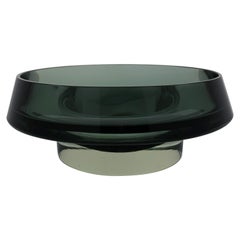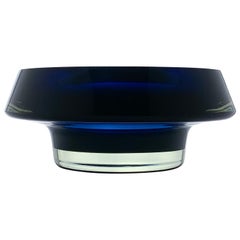Kaj Franck Kf 261
Recent Sales
Vintage 1960s Finnish Scandinavian Modern Decorative Bowls
Glass, Cut Glass, Art Glass, Blown Glass
Vintage 1960s Finnish Scandinavian Modern Decorative Bowls
Glass, Art Glass, Blown Glass
Kaj Franck for sale on 1stDibs
Kaj Gabriel Franck was a leading figure in 20th-century Finnish design, specializing in ceramics and glass. As the creative director of Arabia Ceramics, now part of Iittala, he, along with fellow Finns Timo Sarpaneva and Tapio Wirkkala, helped popularize the bright, warm and curvy aesthetic of Scandinavian modernism. Design Forum Finland’s Kaj Franck Design Prize, established in 1992 and awarded each year around his birthday, is among the country’s most prestigious honors for designers.
Franck was born in 1911 in the city of Vyborg, which now belongs to Russia, but was then part of the Grand Duchy of Finland. He studied furniture design at the Central School of Industrial Design in Helsinki, and after graduating in 1932, worked as a catalogue illustrator for the Riihimäki glassworks, exploring interior and textile design on the side.
Having served in the Finnish armed forces during World War II, Franck joined Arabia in 1945 as their head of design. He remained with the company for many years, steering its line of tableware in a dynamic new direction. Franck professed an aversion to superfluous ornament. His ceramic designs were nevertheless complex and eye-catching, animated with playful, geometric forms. One of his most famous creations for Arabia was the Origami dish from the early 1960s, a glossy all-white serving piece resembling a subtly folded piece of paper with four shallow sections for holding food.
Although his Arabia ceramics became household staples for consumers in Scandinavia and beyond, Franck is better known among collectors for his glass designs, particularly those he created for Iittala starting in the late 1940s. In a 1947 Iittala-sponsored glass competition, Franck shared the top prize with Tapio Wirkkala. In 1950, he designed the company’s iconic Kartio series of pressed-glass pitchers and glasses, which came in different colors that consumers could “mix and match” rather than having to buy a homogeneous set. In 1977, Franck redesigned the series, renamed Teemaa.
Franck’s designs for Iittala embodied the Finnish concept of pelkistetty, which literally means “reduced” and in the design world refers to the pared-down, minimal qualities of modernism. This principle, evidenced in objects like his elegant, unfussy sets of jewel-toned drinking glasses from the 1960s, informed Franck’s view of the manufacturing process as well. Critical of mass production and consumerism, he was one of the country’s first professionals in his field to advocate recycling. He became known as the “conscience of Finnish design,” a role he embraced as a professor and later artistic director at the University of Art and Design in Helsinki.
In honor of Franck’s 100th birthday, in 2011, Iittala reissued Kartio glasses, Teema tableware and Purnukka jars, among other of his designs that retain their contemporary feel decades after their creation.
Find vintage Kaj Franck glass, vases and other furniture and decor on 1stDibs.
A Close Look at Scandinavian-modern Furniture
Scandinavian modernism is perhaps the warmest and most organic iteration of modernist design. The work of the designers associated with vintage Scandinavian modern furniture was founded on centuries-old beliefs in both quality craftsmanship and the ideal that beauty should enhance even the humblest accessories of daily life.
ORIGINS OF SCANDINAVIAN MODERN FURNITURE DESIGN
- Emerged in the 1930s
- Scandinavian design and Nordic design originated primarily in Denmark, Sweden, Finland, Iceland and Norway
- Introduced in the United States in mid-20th century
- Informed by the Bauhaus; influenced American mid-century modernism
CHARACTERISTICS OF SCANDINAVIAN MODERN FURNITURE DESIGN
- Bold, clean lines and simple, sturdy symmetries
- Use of natural materials — native woods such as pine, ash and beech
- Open, airy spaces
- Promotion of functionality
- Emphasis on craftsmanship; rooted in cabinetry profession and traditional construction techniques
- Minimal ornamentation (little to no embellishment)
- A neutral or light color palette owing to prominence of light woods
SCANDINAVIAN MODERN FURNITURE DESIGNERS TO KNOW
- Alvar Aalto
- Hans Wegner
- Kaare Klint
- Arne Jacobsen
- Greta Magnusson Grossman
- Finn Juhl
- Arne Vodder
- Verner Panton
ICONIC SCANDINAVIAN MODERN FURNITURE DESIGNS
VINTAGE SCANDINAVIAN MODERN FURNITURE ON 1STDIBS
The gentle, organic contours that are typical of Scandinavian design appear in the furnishings and decor created by Danish, Finnish and Swedish designers not as a stylistic gesture, but rather as a practical, ergonomic — and, as importantly, elegant — response to the human form.
Each nation produced exceptional talents in all areas of the applied arts, yet each had its forté. Sweden was home to Greta Magnusson Grossman and Bruno Mathsson — creators of the classic Grasshopper lighting series and Berlin daybed, respectively — but the country excelled most notably at ceramics. In the 1920s at the great Gustavsberg porcelain manufactory, Wilhelm Kåge introduced pieces in the Scandinavian style based on influences from folklore to Cubism; his skills were passed on to his versatile and inspired pupils Berndt Friberg and Stig Lindberg.
Likewise, Finland produced a truly ingenious Scandinavian modern furniture designer in the architect Alvar Aalto, a master at melding function and artistic form in works like the Paimio chair, created in collaboration with his first wife, Aino. Yet Finnish glassware was pre-eminent, crafted in expressive, sculptural designs by Tapio Wirkkala and Timo Sarpaneva.
The Danes excelled at chairs. Hans Wegner and Arne Jacobsen were exemplars of the country’s facility with wood, particularly teak.
Wegner created such iconic pieces as the Round chair and the Wishbone chair; Jacobsen — while the revolutionary architect and furniture innovator produced the best-selling plywood Ant chair — designed two classic upholstered pieces of the 1950s: the Swan chair and Egg chair. The list of great Danes could go on and on, including Finn Juhl, a stylistic maverick and maker of the bold Chieftain chair; Poul Kjaerholm, with his lean metal-and-rattan aesthetic; and Verner Panton, who introduced a vibrant Pop note into international design.
Today, decades after their heyday, the prolific, ever-evolving Scandinavian modernists continue to amaze and delight, and interior designers all over the world use their pieces to bring warmth to any given space.
On 1stDibs, you will note both instantly recognizable vintage Scandinavian modern chairs, sofas, rugs and tables — those that have earned iconic status over time — and many new discoveries.
Finding the Right Decorative-bowls for You
Vintage, new and antique decorative bowls have been an important part of the home for centuries, although their uses have changed over the years. While functional examples of bowls date back thousands of years, ornamental design on bowls as well as baskets likewise has a rich heritage, from the carved bowls of the Maya to the plaited river-cane baskets of Indigenous people in the Southeast United States.
Decorative objects continue to bring character and art into a space. An outdoor gathering can become a sophisticated garden party with the addition of a few natural-fiber baskets to hold blankets or fruit on a table, as demonstrated in the interior design work by firms such as Alexander Design.
Elsewhere, Richard Haining’s reclaimed wood vases and bowls can express eco-consciousness. Sculptural handmade cast concrete bowls like those made by the Oakland, California–based UMÉ Studio introduce compelling textures to your dining room table.
Minimalist ceramic decorative bowls of varying colors can evoke a feeling of human connectedness through their association with handmade craftsmanship, such as in the rooms envisioned by South African interior designer Kelly Hoppen. And you can elevate any space with ceramic bowls that match the color scheme.
Browse the 1stDibs collection of decorative bowls and explore the endless options available.

